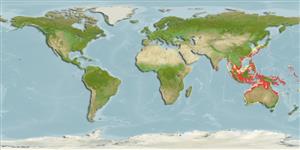Gastropoda |
Ostreida |
Margaritidae
Environment: milieu / climate zone / تغييرات عمق / distribution range
بوم شناسي
; تغييرات عمق 0 - 60 m (مرجع 348), usually 5 - 30 m (مرجع 348). Tropical
Indo-West Pacific: from Nicobar and Andaman Islands to Melanesia; north to Japan and south to Queensland and Western Australia; Borneo and Moluccas.
Length at first maturity / Size / Weight / سن
بلوغ: Lm ? range ? - ? cm Max length : 30.0 cm ShL جنس نر / بدون خواص جنسي; (مرجع 348); common length : 20.0 cm SHH جنس نر / بدون خواص جنسي; (مرجع 348)
Shell rather thick and large (attaining 30 cm in length), subcircular in outline, with a short and ill-defined posterior ear which is not drawn out into a wing-like process. Anterior margin markedly protruding beyond the tip of anterior ear. Outer surface of valves, when not worn, covered with flattened, imbricating concentric scales bearing large and irregular, flat spines with blunt ends, roughly arranged in radial rows and projecting at shell margins. Hinge completely devoid of teeth. Colour: outside of shell uniformly fawn, sometimes with radial stripes of darker spots in umbonal region; then, ground colour in that region green, dark brown, or purple. Internal nacreous area highly lustrous, silvery with a variably extended golden border. Non-nacreous margin clear, of plain horny colour.
Mainly in clear water under the influence of currents. Often in dense colonies. Littoral and sublittoral to a depth of 60 m; most common from sublittoral at depths of 5 to 30 m (Ref. 348). On various bottoms, byssally attached to hard substrates at least in the young stages (Ref. 348). Inhabits a broad range of habitat, from sand, mud, gravel, seagrass beds, deep-water reefs, to near sponges, soft corals or whip corals. Filter-feeder (Ref. 101206).
Life cycle and mating behavior
بلوغ | تولید مثل | تخم ریزی | Eggs | Fecundity | Larvae
Members of the class Bivalvia are mostly gonochoric, some are protandric hermaphrodites. Life cycle: Embryos develop into free-swimming trocophore larvae, succeeded by the bivalve veliger, resembling a miniature clam.
مآخذ اصلی
مراجع | هماهنگ كننده | همكاران
SAUP Database 2006 SAUP Database. www.seaaroundus.org. (مرجع 356)
وضعيت در فهرست قرمز IUCN
(مرجع 130435: Version 2025-1)
وضعيت از نظر سايتس (مرجع 108899)
Not Evaluated
Not Evaluated
خطر برای انسان ها
استفاده انسانی
ماهي گيري – شيلات: تجاري
| FishSource | Sea Around Us
ابزارها
اطلاعات بيشتر
Life cycleتولید مثلبلوغFecundityتخم ریزیEggsنمو تخمLarvae PhysiologyOxygen consumption
Human RelatedStamps, coins, misc.
منابع اينترنتي
Estimates based on models
Preferred temperature
(Ref.
115969): 24.4 - 29.1, mean 28.2 (based on 1342 cells).
جهندگی
زياد, كمينه زمان لازم براي دو برابر شدن جمعيت ، كمتر از 15 ماه (K=0.72-0.79).
Fishing Vulnerability
Low vulnerability (18 of 100).
طبقه قيمت
Unknown.
Nutrients : Calcium = 149 [71, 228] mg/100g; Iron = 8.53 [1.95, 15.11] mg/100g; Protein = 9.88 [8.64, 11.12] %; Omega3 = 0.313 [0.202, 0.423] g/100g; Selenium = 61 [50, 72] μg/100g; VitaminA = 0 μg/100g; Zinc = 2.04 [0.56, 3.51] mg/100g (wet weight); based on
nutrient studies.
